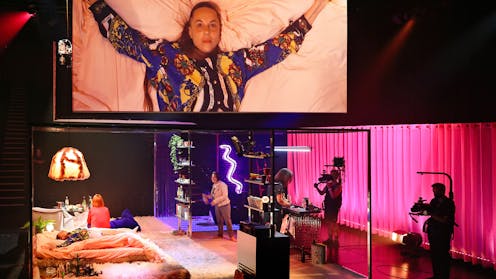Comic anticlimax in Nat Randall and Anna Breckon’s Set Piece
- Written by Sarah Balkin, Lecturer, English and Theatre Studies, The University of Melbourne

Review: Set Piece, by Nat Randall and Anna Breckon, for Rising.
Nat Randall and Anna Breckon’s Set Piece explores female intimacy through the relationship between screen and stage, drawing on dinner party conversation, improvisation and lesbian pulp fiction. Its generic situation and looping repetition combine to stage lesbian fantasy with a comic anticlimax.
In theatre, a set piece can refer simply to a piece of freestanding scenery. But it is also a genre term that suggests a formally composed scene or speech. In film, a set piece is sometimes defined[1] as an elaborate scene “in which several plot elements are brought to a climax and resolved” (such as the ending sequence of The Godfather, in which the Don’s enemies are killed).
But Marshall Thornton argues against this definition; he instead links the filmic set piece to its origins in vaudeville acts where comedians would have a collection of “set pieces” they could perform on demand, often several times a night. A set piece is sometimes a highlight, Thornton argues[2], but the essential element is that it is self-contained; rather than resolving everything, “usually, it’s something a little bit tangential that could be removed from your film”. Classic set pieces include food fights, weddings and party scenes.
Randall and Breckon play with multiple definitions and connotations of a set piece. The whole play is the tangential scene. It is set at the tail end of a party in a freestanding apartment with transparent walls.
The trendy apartment in a gentrified neighbourhood belongs to a long-term lesbian couple played by Maude Davey and Dina Panozzo. Their guests are a younger, married lesbian couple played by Carly Sheppard and Randall. I forgot the characters’ names immediately, but it didn’t much matter: they are de-idealised or “compromised[3]” lesbian archetypes more than fully realised characters.
Randall’s babified drunkenness also seemed patterned on Honey from Edward Albee’s Who’s Afraid of Virginia Woolf, which loosely inspired Set Piece. The intergenerational seductions in Set Piece reference lesbian fantasy and explore queer possibilities for the genre of the “marriage drama”, as Breckon and Randall note in their Q&A with Arts House. Indeed, one of the older characters briefly questions the younger couple about whether marriage is still heteronormative, but the younger characters don’t respond beyond brief annoyance and an assertion that “it isn’t, anymore”.
The production treads lightly over this gap in perspective, which it juxtaposes with the eroticism of intergenerational relationships.
The see-through set gives audiences and simulcasting cameras views of mundane and erotic details: characters use the toilet, bring snacks and drinks from the kitchen, dance, and seduce each other’s partners.
While I generally find the use of simulcast film in theatre makes it difficult for me to watch the live actors, that wasn’t the case here. It helped that I sat in the front row on the same level as the set and the screens were mounted above it. The cameras were a reminder of the highly mediated nature of the seemingly intimate, interior action.
They were also a source of comic realism, especially when providing a bird’s-eye view of what was arguably Set Piece’s best bit: when Randall’s character, lying under a transparent table, painstakingly navigated a potato chip from the table to her mouth. The moment of drunken focus perfectly encapsulated the feeling of a party winding down — the “end of night dregs”, as Breckon described it in an interview[4].
While the characters are drunk and high, the actors are tightly choreographed, hitting their marks for the cameras and cycling through several iterations of the same scene, with slightly different dialogue and outcomes each time. Breckon described the looping iterations as a kind of “edging[5]”, a sexual practice where a person brings themself or their partner to the edge of orgasm and then backs off, with the aim of making the eventual orgasm more intense.
But Set Piece builds to a series of anti-climaxes: in its final iteration, Sheppard and Panozzo’s characters finally do have sex after an erotic build-up through the other loops. “They’re really going for it”, Randall’s character – who has donned a glass strap-on dildo but was not invited to join in – confides to Davey, a jaded writer who accepts all with equanimity. But the play casts doubt on whether anyone achieves orgasm. “Did you …?”, Sheppard says in the afterglow, and Panozzo replies, “I’m sorry … I’m just so drunk”.
Meanwhile, Davey and Randall share their own scene of comically failing to have sex. Randall, who is lying on the floor, asks if she can lick Davey’s ankle. “I think that would be all right”, Davey replies. They then try kissing, but Randall finds she doesn’t want to keep going. “I’m sorry”, she says. “It’s all right”, Davey replies.
When the younger couple reunite outside the toilet, Randall is still wearing the strap-on beneath her wine-stained button-down shirt. Sheppard laughs out loud at her – it didn’t feel like a mean-spirited laugh, to me – and the scene blacks out. It was the only time I believed Sheppard and Randall’s characters were married.
This deflationary ending undercuts lesbian fantasy with what Breckon and Randall call the queer ordinary[6]. Set Piece’s iterated edging and low-affect intimacy suggest the queer possibilities of its marriage drama may lie in maintaining a tone where emotion isn’t “pushed to a dramatic level[7]”.
Set Piece is at the Meat Market until June 12.
References
- ^ sometimes defined (www.oxfordreference.com)
- ^ Thornton argues (screenwritingmagazine.com)
- ^ compromised (www.artshouse.com.au)
- ^ described it in an interview (www.rrr.org.au)
- ^ edging (www.rrr.org.au)
- ^ queer ordinary (rising.melbourne)
- ^ pushed to a dramatic level (www.rrr.org.au)
Read more https://theconversation.com/comic-anticlimax-in-nat-randall-and-anna-breckons-set-piece-183624














